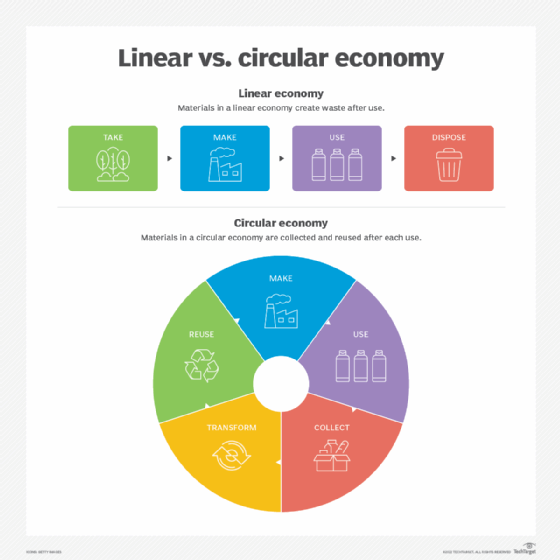circular economy
What is a circular economy?
A circular economy is a model of production and consumption, where items and products are reused whenever possible rather than discarded. Taking the cynical approach, circular economy is a fancy way of saying used products.
The circular economy is a sustainable economic model that focuses on reusing and recycling materials to reduce the consumption of natural resources and avoid waste creation.
The term was coined in 2010 by Dame Ellen MacArthur, an English competitive sailor who established a foundation in her name to promote what she called the circular economy.
The term has a broad application to all industries. But for IT purposes, a circular economy means refurbishing, reselling and reusing used IT equipment.
How a circular economy works and why it's important
The goal of the circular economy is to keep materials in circulation for as long as possible through reuse, remanufacturing and recycling as well as making products as durable as possible. The circular economy aims to address climate change, biodiversity loss, e-waste and pollution by focusing on three principles throughout the product lifecycle:
- Minimization of waste and pollution. This principle advocates minimizing waste and pollution by reducing damages from economic activities -- namely, buying new products rather than buying used products.
- Extension of the useful life of products and materials. This is a key concept as relates to IT. The goal is achieved through the active reuse, repair and remanufacturing of the products and materials used in the economy.
- Regeneration of natural systems. The regeneration of natural systems is one of the fundamental concepts of a circular economy. It enhances natural capital and creates the necessary conditions for the regeneration of natural systems.
The circular economy is important for more than just virtue signaling. Efficient recycling reduces the need for resources that may be scant, particularly rare earth minerals/metals. These minerals -- with names such as europium, gadolinium and neodymium -- found in very few places on earth are important in the manufacturing of electronic devices, particularly smartphones.
The circular economy helps efficiently use available resources and eases the burden of raw material shortage. This, in turn, reduces the effects on the environment through reduced mining and resource development.
The environmental benefits from the circular economy include using fewer natural resources and reducing energy consumption and waste production. This reduces carbon emissions and saves natural resources.
For all its benefits, the circular economy is not a magic bullet. There are downsides to it, though they don't always apply to the IT side of things. Businesses might find the cost of implementing this system out of reach. Moreover, what should be considered waste can be subjective, as can measuring how much waste is being produced. But not everything can be recycled or reused.
Linear economy vs. circular economy
In a linear economy, natural resources are turned into finished goods that are ultimately disposed of and not given a second chance at use or life. A circular economy is built on reuse, repair, refurbishment and recycling to create a loop system of reuse.
The goals of each are different too. The linear economy maximizes profit. It can be easier and cheaper to dispose of a product than to recycle it. The effort to recycle and reuse products takes time and money.
The goal of the circular economy is sustainability, which requires extra effort. Greater costs may be incurred depending on the industry and the product involved.

The circular economy of IT
There has always been an aftermarket for used computing equipment. Most of it was for older equipment that was no longer supported by the vendor.
In fact, as more IT equipment has come on the market -- particularly with the advent of hyperscale computing providers such as AWS and Google -- more used equipment was hitting the market.
While it may be easy to recycle individual items such as laptops, something more formal and structured was necessary to handle large volumes of IT equipment such as servers, storage and networking gear. A key concern was safely disposing this type of equipment due to data sensitivity concerns. For this, a more formal process was necessary -- one that eventually led to the development and formalization of the circular economy.
A leader in the IT circular economy is Iron Mountain, a company focused on reselling used equipment that was decommissioned by hyperscalers such as Facebook and Google. These companies are more aggressive in turning over equipment -- about one to two years -- compared to enterprises who keep IT equipment for five to seven years.
The reason for the rapid turnover is that with each generation, hardware gets more power efficient. For a hyperscaler deploying servers 5% more power efficient, that translates into savings, reduced operational expenses and increased profitability.
Iron Mountain refurbishes older servers and resells them for half their original value. Medium to large enterprises can purchase relatively new hardware that has been fully tested and is protected by a warranty at a bargain price.
In addition to Iron Mountain, every major server vendor has a recycling program where they take back old gear and repurpose it.
Benefits of a circular economy
The benefits of adopting circular economic principles include the following:
- reduced need for natural resources, energy, water consumption and waste production;
- reduced carbon emissions;
- reduced environmental effects of the linear economy;
- reduced waste by promoting the recycling of finished goods;
- fewer price increases; and
- premium IT equipment at a bargain price.
Learn some tips for businesses going green.
